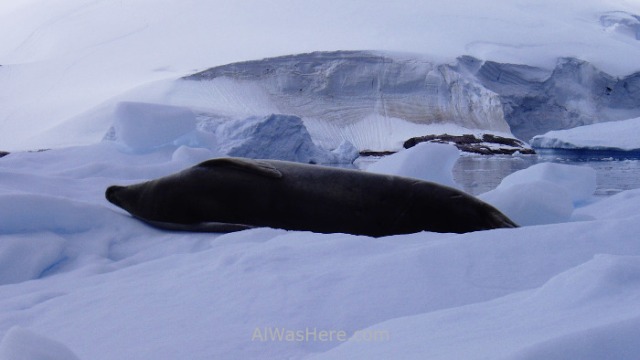- I was here the afternoon of December 28, 2007 for about 4 hours.
- My score: 4/5.
Leaving Cuverville Island behind we continue towards Neko Harbour, the first stop of the trip on the continent as such, since so far all our stops in Antarctica had been made on islands. To get there, the most natural way is the small Errera Channel, located south of Cuverville.
ERRERA CHANNEL
Discovered and crossed for the first time by the same Belgian expedition that discovered Cuverville Island in 1897, it runs between Ronge Island and Danco Coast. It measures about 10 kilometers long and is quite wide. Its main attraction is the presence of icebergs that emerge from the glaciers that flow into the bay where Neko Harbour is, although in our case, the sightings of these usually beautiful pieces of floating ice were not significant, much better were those around Cuverville Island and those we already found in Neko Harbour itself.






NEKO HARBOUR
This is where the good begins. Neko Harbour is a magnificent natural harbor south of Andvord Bay, just where the Errera Canal ends, so much that a Scottish whaling ship, the Neko, used it as a base of operations for several seasons between 1911 to 1924, giving it its name.

The bay is closed enough for huge glaciers to surround it on 3 of the 4 sides, cracking at the touch of the sea, Neko Harbour being one of the places with the largest number of icebergs on the Antarctic Peninsula, which are its main attraction.






In addition to the icebergs, in Neko Harbour we also had our first contact with a type of animals that we had not seen so far, the seals, of which we sighted 3 types:
- Crabeater seal. This type of seal is a paradox itself, since it does not eat crabs, although small crustaceans, and never having seen it, it turns out to be one of the most common mammals on the planet, with a population of more than 15 million individuals (some studies suggest that its population could reach 75 million). It is typical of Antarctica, although it can be found in New Zealand, Australia, South Africa and the southern cone of South America. Adult specimens weigh between 200 and 300 kg and their coat changes from light brown from summer to dark brown in winter. Live on the floating ice blocks.



- Weddell seal. This seal reaches twice the size and weight of its neighbor the crabeater, being one of the largest seals that exist. It lives basically in Antarctica, in fact it is considered the mammal that lives further south of the planet, but some specimens have also been seen on the coasts of Oceania, Africa and South America. Its coat is dark gray with frequent light gray spots and some black spots. These seals are famous for being able to dive up to 600 meters deep. It is believed that there are about 500,000 specimens.


- And the most striking is the Leopard Seal, and it is that aggressive carnivores are usually the ones that cause the most fascination. This seal also eats small crustaceans, squid, cod and those things as healthy as its congeners, but it goes for everything that moves and fits in its mouth, which includes any penguin that comes close to it and even other seals, especially if they are young. Everything in its form reminds of a predator; the head is sharp and the thorax much wider than that of other seals, with powerful front fins. The head and back are dark gray and the belly light gray; females are almost twice as large as males, reaching some 600 kg. This type of seal sometimes reaches more north than the previous ones, with sightings in Cook Islands and Brazil.




And of course, a great attraction in Neko Harbour is to step on the continent as such for the first time. We spend a lot of time in the zodiacs and hardly any time in the port, but there are excursions that even small walks are allowed.


<FULL CRUISE ITINERARY TO ANTARCTICA
PORT LOCKROY>
LEMAIRE CHANNEL>
PLENEAU ISLAND>
PETERMANN ISLAND>

Pingback: PUERTO NEKO Y CANAL DE ERRERA, ANTÁRTIDA – Al Was Here
Pingback: CUVERVILLE ISLAND, ANTARCTICA – Al Was Here
Pingback: HALF MOON ISLAND, ANTARCTICA – Al Was Here
Pingback: DECEPTION ISLAND, ANTARCTICA – Al Was Here
Pingback: DRAKE PASSAGE OR SEA OF HOCES – Al Was Here
Pingback: Antarctica – Al Was Here
Pingback: PARADISE BAY, ANTARCTICA – Al Was Here
Pingback: PORT LOCKROY, ANTARCTICA – Al Was Here